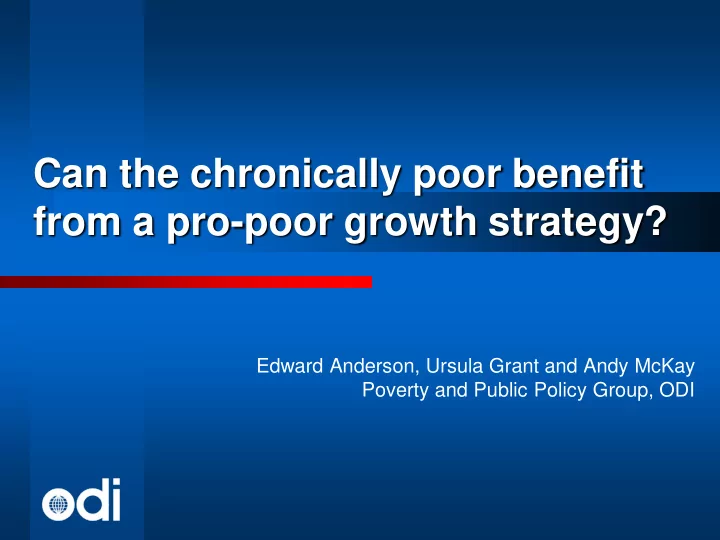

Can the chronically poor benefit from a pro-poor growth strategy? Edward Anderson, Ursula Grant and Andy McKay Poverty and Public Policy Group, ODI
Introduction Conventional view: growth for poverty reduction Direct and indirect benefits But can this include the chronic poor? – Vulnerable groups; fragile livelihoods Preliminary assessment based on current country level evidence
Introduction (continued) ODI research (DFID supported) – Lessons for poorest from 14 country case studies from multi-donor Operationalising Pro-Poor Growth project – Household trajectories over time: Uganda – Non-income dimensions: Ghana and Uganda Preliminary, incomplete picture; comments welcome
Finding 1: poorest included in growth where it happened Average incomes of poorest 10% grew in countries experiencing positive growth e.g. 0.9% per year increase in Bangladesh, 2.9% in Uganda, 4.1% in Vietnam Incomes of poorest 10% fell in Romania (negative growth)
Finding 2: but the poorest did not benefit in proportion In some cases incomes of the poorest grew faster than average … But in majority of cases they grew less Some tendency to increased inequality with growth
Finding 2 continued: cases of increasing inequality Growth rates for poorest 10% and national growth rates 6 5 4 3 Growth rate (% p.a.) 2 1 0 Bangladesh Brazil 1993- El Salvador Ghana India 1994- Senegal Romania Vietnam -1 1991-2000 2001 1991-2000 1991-1998 2000 1994-2001 1996-2002 1992-2003 -2 -3 -4 Poorest 10% Average growth rate
Finding 2 continued: and some pro-poor(est) cases Growth rates for the poorest 10% and national growth rates 6 5 4 Growth rate 3 2 1 0 Bolivia 1989-2002 Burkina Faso 1994- Indonesia 1996- Uganda 1992-2003 Zambia 1991-1998 2003 2002 Poorest 10% Average growth rate
Finding 3: “pro - poorest” growth has distinctive characteristics Examples from different country case studies: Reduced urban-rural gap and/or strong performance of agriculture Poorest sometimes less hit by downturns Political economy focused on poorest groups Infrastructure Public spending beneficial to poorest
Finding 3 (continued) Many reasons why may be harder for chronic poor to participate in growth e.g. – Lack of assets – Severe vulnerability – Political exclusion However public policy, especially public spending, can offset
Finding 4: considerable downward and upward mobility Follow same households over time to observe mobility … and identify persistent poor Uganda shows considerable mobility … and fast average growth among poorest Substantial vulnerability
Finding 4 (continued) Annual growth rate of consumption for panel households in Uganda, by percentile, 1992 to 1999 25 20 15 10 5 0 0 10 20 30 40 50 60 70 80 90 100 -5 Percentile
Finding 5: mixed evidence on non- income indicators Importance of looking at non-income welfare indicators (e.g. education, health, vulnerability) Evidence of such indicators from household surveys in Ghana and Uganda during the 1990s shows a mixed picture.
Finding 5 (continued) On the positive side: – Large increases in primary school enrolment and completion rates among the poorest in both countries – Similarly large increases in child vaccination rates among the poorest in Ghana.
Finding 5 (continued) On the negative side: – 12% of surveyed households in Ghana remained asset-less in 1999, and therefore vulnerable to shocks; – Large reductions in child vaccination rates (bcg, measles, dpt) in Uganda
Summary Need for further work However important that the chronic poor are connected with growth … implications for type of growth But growth alone insufficient … and much too slow to reduce chronic poverty – Measures to reduce inequality
Summary (continued) Key role for public spending in relation to chronic poor: not just social sector Insecurity as a major issue – key role for social protection
Recommend
More recommend